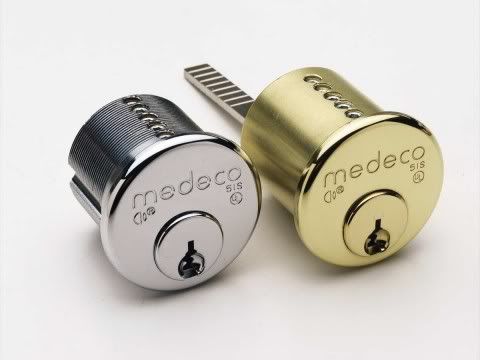Enough talking and lets begin.

This is the lock. It's a small euro profile oval that I replaced from a previous job. It's a knock off of the Cisa and made in China.

This is the front view.

On the top of the lock you can see the holes in which the pins etc goes in.

The lock is first centre punched to enable a precise drilling point. Then very cautiously, the top or closing pins are drilled out. With this milling machine I just need to attatch my drill to the press and I have a milling machine.

The first pin out. Remove all the pins. What I found was a great help is to put each pinset (the pins and springs etc) in a small packet and number the packets eg the 1st pin set in packet number one. This way when I'm reassemling it or repinning, I'd know where it should go.

All the pins removed and numbered. Incidently pin Number 2 & 3 are mushroom pins.

This is the grub screw and allen key I had a problem getting. Now I know that it can eaily be found at engineer supply stores. The secret to this practice lock is instead of using a closing pin, which will make it semi perminent( have to drill out the closing pin), I've put in a grubb screw that can just be unscrewed and a new\ another pin can be replaced easily.

These are the four pins ready to be inserted into the lock.

The lock withonly one pin in it ready to be picked.

Easily picked. The objective of this is to check the tension of the tension bar or wrench. By applying too little or too much pressure, you can see the effects and this way you can get this tension correct. I read somewhere that the tension on the wrench is the important part. Playing around with varied tension helps with picking process. Another objective is to gain confidence in the picking process. When I have a problematic lock I go back to this lock and start all over with one pin in. Sort of like going back to basics. My attitude is 'if I can do it here, I can do it anywhere'

Two pins & ............................

Still easy

All five pins in. A little more of a challenge.

Open. If at any stage difficulty is experienced, all you need to do is just to go one pin back and build your confidence up and practice on your technique. By also practicing the lock picking process, you learn the fine techniques of lock picking eg fine motor skills. Picking pin by pin. Also build the hand muscles especially in the ball of your hand. Good luck with your practice locks and I have my eye on another lock to convert to a practice lock. I also intend using this method on a mortice lock. I'll be back





